Report on HR Development: Learning Styles and Training at McDonald's
VerifiedAdded on 2019/12/18
|13
|3938
|335
Report
AI Summary
This report provides a comprehensive analysis of Human Resource Development (HRD) practices within McDonald's. It begins by comparing different learning styles, including Honey and Mumford, Kolb's, and Myers-Briggs, and their application in the context of McDonald's employee training. The report then examines the role of the learning curve and the importance of transferring learning to the workplace. It details the planning and design of learning events, considering the contribution of various learning styles and theories. The report further compares the training needs of restaurant managers, shift floor managers, and customer service assistants, evaluating the merits and demerits of different training methods, such as on-the-job and off-the-job training. It proposes a plan for training and development for each role. The evaluation of staff using suitable techniques and the review of evaluation models are also discussed, with a focus on identifying the most appropriate formal and informal evaluation techniques to enhance training effectiveness. Finally, the report critically evaluates evaluation models and styles for McDonald's.
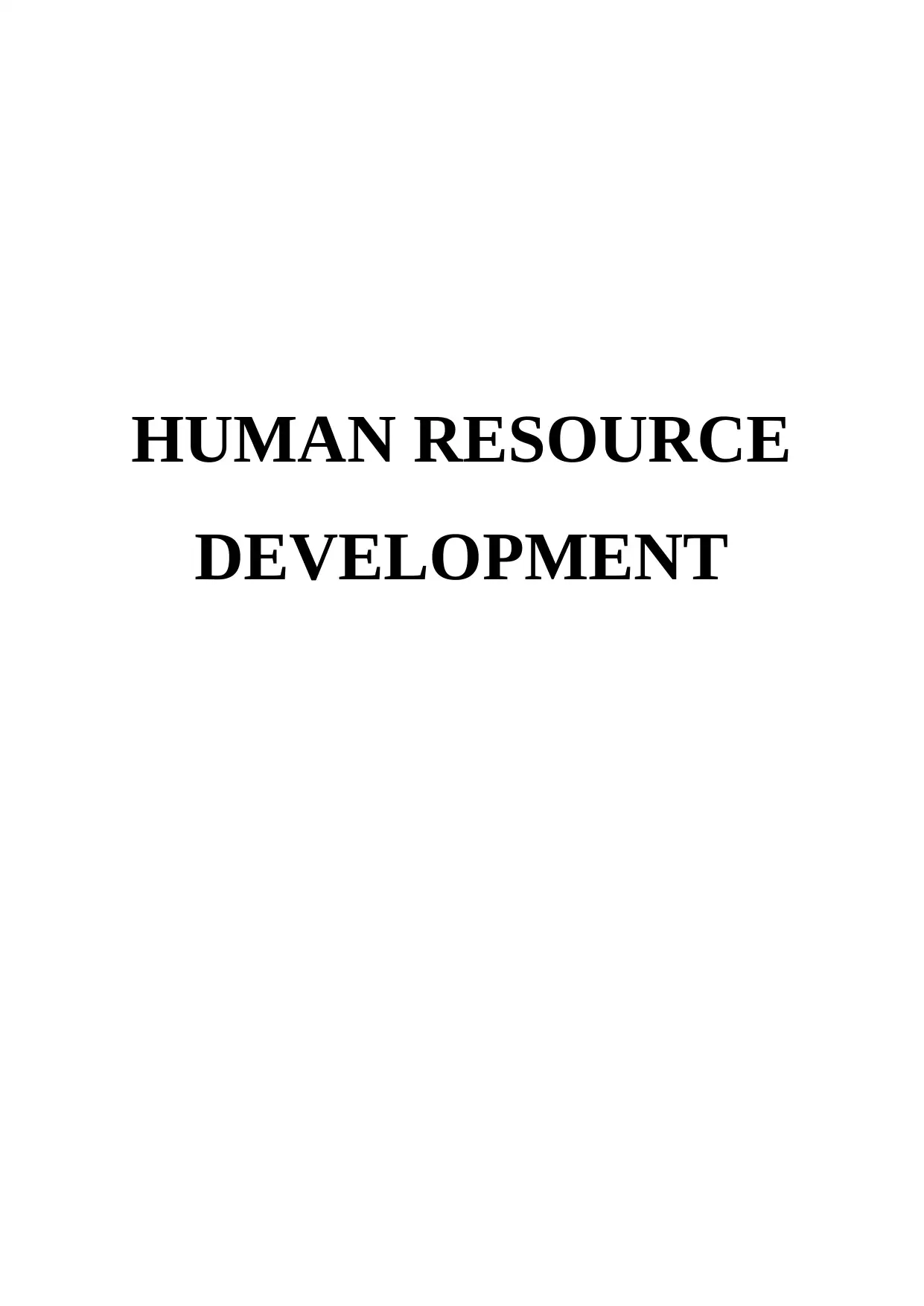
HUMAN RESOURCE
DEVELOPMENT
DEVELOPMENT
Paraphrase This Document
Need a fresh take? Get an instant paraphrase of this document with our AI Paraphraser
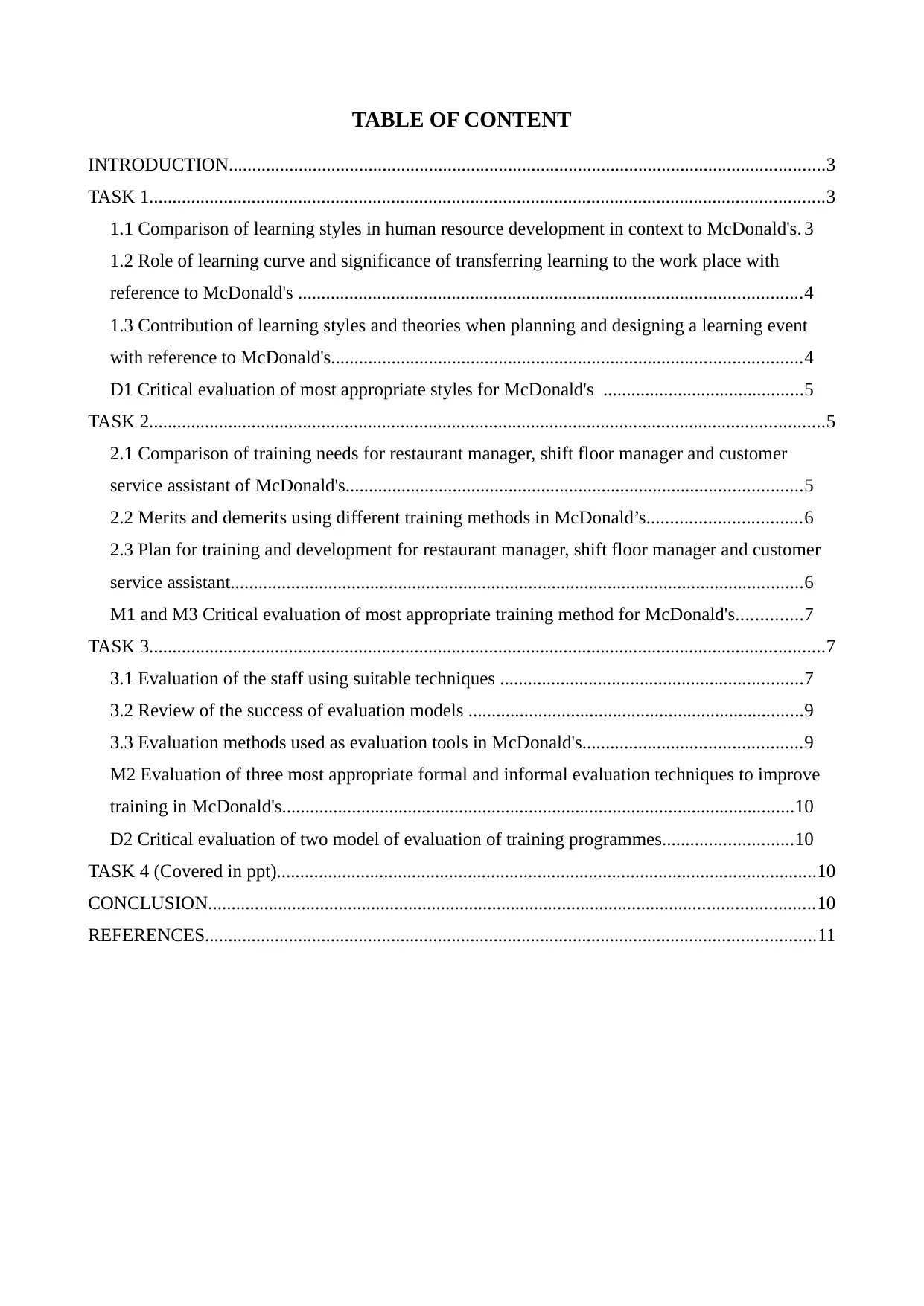
TABLE OF CONTENT
INTRODUCTION................................................................................................................................3
TASK 1.................................................................................................................................................3
1.1 Comparison of learning styles in human resource development in context to McDonald's. 3
1.2 Role of learning curve and significance of transferring learning to the work place with
reference to McDonald's ............................................................................................................4
1.3 Contribution of learning styles and theories when planning and designing a learning event
with reference to McDonald's.....................................................................................................4
D1 Critical evaluation of most appropriate styles for McDonald's ...........................................5
TASK 2.................................................................................................................................................5
2.1 Comparison of training needs for restaurant manager, shift floor manager and customer
service assistant of McDonald's..................................................................................................5
2.2 Merits and demerits using different training methods in McDonald’s.................................6
2.3 Plan for training and development for restaurant manager, shift floor manager and customer
service assistant...........................................................................................................................6
M1 and M3 Critical evaluation of most appropriate training method for McDonald's..............7
TASK 3.................................................................................................................................................7
3.1 Evaluation of the staff using suitable techniques .................................................................7
3.2 Review of the success of evaluation models ........................................................................9
3.3 Evaluation methods used as evaluation tools in McDonald's...............................................9
M2 Evaluation of three most appropriate formal and informal evaluation techniques to improve
training in McDonald's..............................................................................................................10
D2 Critical evaluation of two model of evaluation of training programmes............................10
TASK 4 (Covered in ppt)....................................................................................................................10
CONCLUSION..................................................................................................................................10
REFERENCES...................................................................................................................................11
INTRODUCTION................................................................................................................................3
TASK 1.................................................................................................................................................3
1.1 Comparison of learning styles in human resource development in context to McDonald's. 3
1.2 Role of learning curve and significance of transferring learning to the work place with
reference to McDonald's ............................................................................................................4
1.3 Contribution of learning styles and theories when planning and designing a learning event
with reference to McDonald's.....................................................................................................4
D1 Critical evaluation of most appropriate styles for McDonald's ...........................................5
TASK 2.................................................................................................................................................5
2.1 Comparison of training needs for restaurant manager, shift floor manager and customer
service assistant of McDonald's..................................................................................................5
2.2 Merits and demerits using different training methods in McDonald’s.................................6
2.3 Plan for training and development for restaurant manager, shift floor manager and customer
service assistant...........................................................................................................................6
M1 and M3 Critical evaluation of most appropriate training method for McDonald's..............7
TASK 3.................................................................................................................................................7
3.1 Evaluation of the staff using suitable techniques .................................................................7
3.2 Review of the success of evaluation models ........................................................................9
3.3 Evaluation methods used as evaluation tools in McDonald's...............................................9
M2 Evaluation of three most appropriate formal and informal evaluation techniques to improve
training in McDonald's..............................................................................................................10
D2 Critical evaluation of two model of evaluation of training programmes............................10
TASK 4 (Covered in ppt)....................................................................................................................10
CONCLUSION..................................................................................................................................10
REFERENCES...................................................................................................................................11
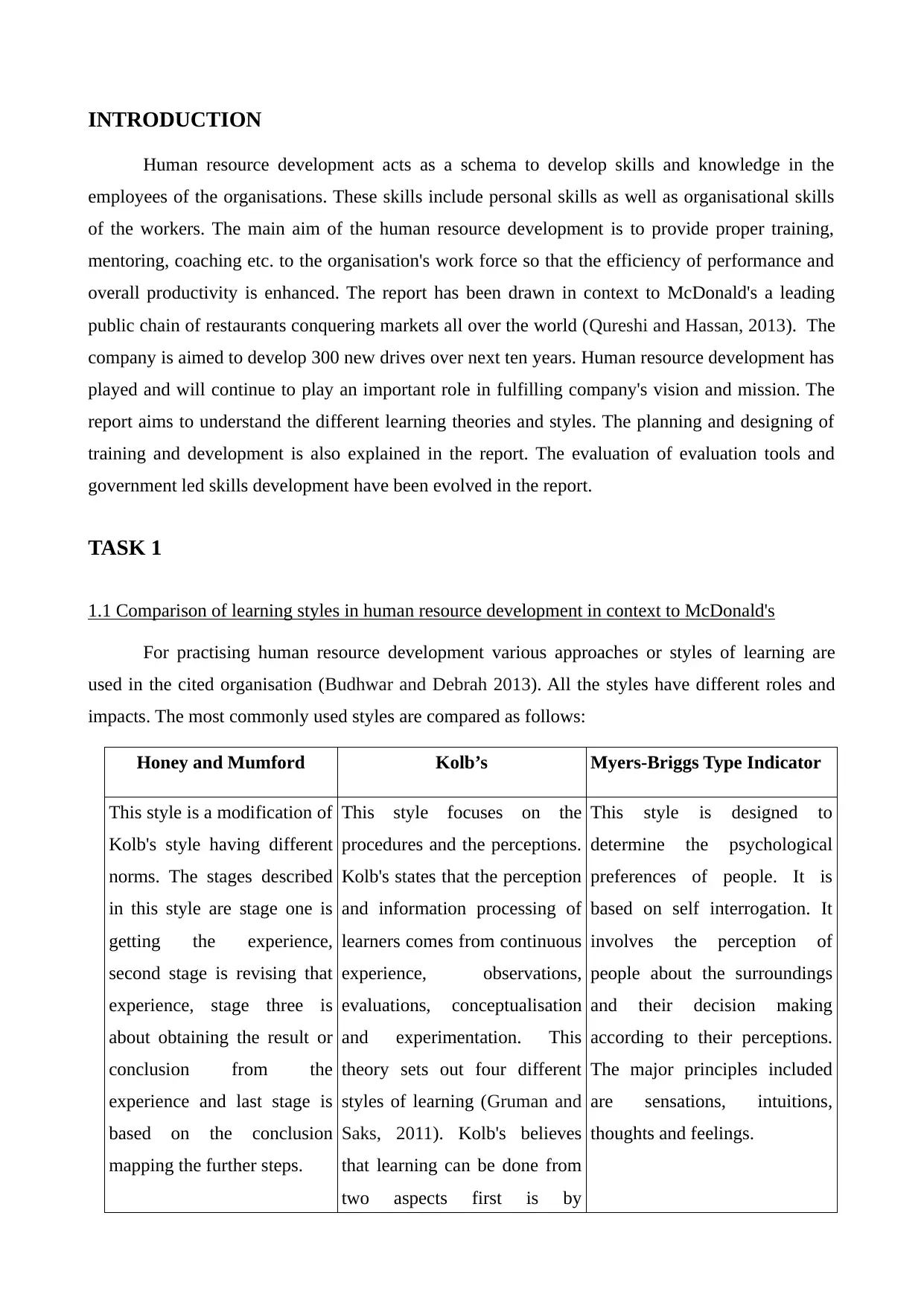
INTRODUCTION
Human resource development acts as a schema to develop skills and knowledge in the
employees of the organisations. These skills include personal skills as well as organisational skills
of the workers. The main aim of the human resource development is to provide proper training,
mentoring, coaching etc. to the organisation's work force so that the efficiency of performance and
overall productivity is enhanced. The report has been drawn in context to McDonald's a leading
public chain of restaurants conquering markets all over the world (Qureshi and Hassan, 2013). The
company is aimed to develop 300 new drives over next ten years. Human resource development has
played and will continue to play an important role in fulfilling company's vision and mission. The
report aims to understand the different learning theories and styles. The planning and designing of
training and development is also explained in the report. The evaluation of evaluation tools and
government led skills development have been evolved in the report.
TASK 1
1.1 Comparison of learning styles in human resource development in context to McDonald's
For practising human resource development various approaches or styles of learning are
used in the cited organisation (Budhwar and Debrah 2013). All the styles have different roles and
impacts. The most commonly used styles are compared as follows:
Honey and Mumford Kolb’s Myers-Briggs Type Indicator
This style is a modification of
Kolb's style having different
norms. The stages described
in this style are stage one is
getting the experience,
second stage is revising that
experience, stage three is
about obtaining the result or
conclusion from the
experience and last stage is
based on the conclusion
mapping the further steps.
This style focuses on the
procedures and the perceptions.
Kolb's states that the perception
and information processing of
learners comes from continuous
experience, observations,
evaluations, conceptualisation
and experimentation. This
theory sets out four different
styles of learning (Gruman and
Saks, 2011). Kolb's believes
that learning can be done from
two aspects first is by
This style is designed to
determine the psychological
preferences of people. It is
based on self interrogation. It
involves the perception of
people about the surroundings
and their decision making
according to their perceptions.
The major principles included
are sensations, intuitions,
thoughts and feelings.
Human resource development acts as a schema to develop skills and knowledge in the
employees of the organisations. These skills include personal skills as well as organisational skills
of the workers. The main aim of the human resource development is to provide proper training,
mentoring, coaching etc. to the organisation's work force so that the efficiency of performance and
overall productivity is enhanced. The report has been drawn in context to McDonald's a leading
public chain of restaurants conquering markets all over the world (Qureshi and Hassan, 2013). The
company is aimed to develop 300 new drives over next ten years. Human resource development has
played and will continue to play an important role in fulfilling company's vision and mission. The
report aims to understand the different learning theories and styles. The planning and designing of
training and development is also explained in the report. The evaluation of evaluation tools and
government led skills development have been evolved in the report.
TASK 1
1.1 Comparison of learning styles in human resource development in context to McDonald's
For practising human resource development various approaches or styles of learning are
used in the cited organisation (Budhwar and Debrah 2013). All the styles have different roles and
impacts. The most commonly used styles are compared as follows:
Honey and Mumford Kolb’s Myers-Briggs Type Indicator
This style is a modification of
Kolb's style having different
norms. The stages described
in this style are stage one is
getting the experience,
second stage is revising that
experience, stage three is
about obtaining the result or
conclusion from the
experience and last stage is
based on the conclusion
mapping the further steps.
This style focuses on the
procedures and the perceptions.
Kolb's states that the perception
and information processing of
learners comes from continuous
experience, observations,
evaluations, conceptualisation
and experimentation. This
theory sets out four different
styles of learning (Gruman and
Saks, 2011). Kolb's believes
that learning can be done from
two aspects first is by
This style is designed to
determine the psychological
preferences of people. It is
based on self interrogation. It
involves the perception of
people about the surroundings
and their decision making
according to their perceptions.
The major principles included
are sensations, intuitions,
thoughts and feelings.
⊘ This is a preview!⊘
Do you want full access?
Subscribe today to unlock all pages.

Trusted by 1+ million students worldwide
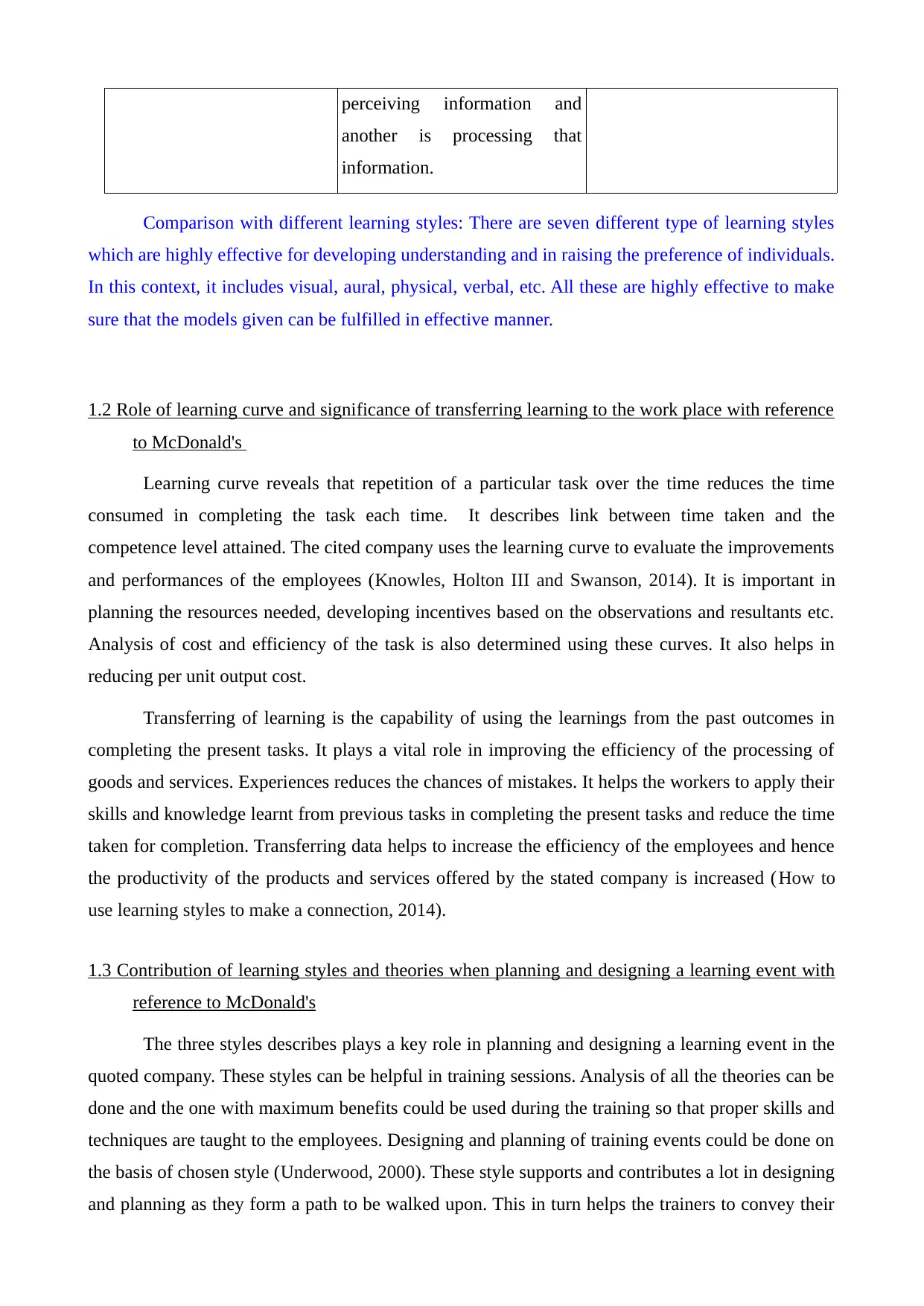
perceiving information and
another is processing that
information.
Comparison with different learning styles: There are seven different type of learning styles
which are highly effective for developing understanding and in raising the preference of individuals.
In this context, it includes visual, aural, physical, verbal, etc. All these are highly effective to make
sure that the models given can be fulfilled in effective manner.
1.2 Role of learning curve and significance of transferring learning to the work place with reference
to McDonald's
Learning curve reveals that repetition of a particular task over the time reduces the time
consumed in completing the task each time. It describes link between time taken and the
competence level attained. The cited company uses the learning curve to evaluate the improvements
and performances of the employees (Knowles, Holton III and Swanson, 2014). It is important in
planning the resources needed, developing incentives based on the observations and resultants etc.
Analysis of cost and efficiency of the task is also determined using these curves. It also helps in
reducing per unit output cost.
Transferring of learning is the capability of using the learnings from the past outcomes in
completing the present tasks. It plays a vital role in improving the efficiency of the processing of
goods and services. Experiences reduces the chances of mistakes. It helps the workers to apply their
skills and knowledge learnt from previous tasks in completing the present tasks and reduce the time
taken for completion. Transferring data helps to increase the efficiency of the employees and hence
the productivity of the products and services offered by the stated company is increased (How to
use learning styles to make a connection, 2014).
1.3 Contribution of learning styles and theories when planning and designing a learning event with
reference to McDonald's
The three styles describes plays a key role in planning and designing a learning event in the
quoted company. These styles can be helpful in training sessions. Analysis of all the theories can be
done and the one with maximum benefits could be used during the training so that proper skills and
techniques are taught to the employees. Designing and planning of training events could be done on
the basis of chosen style (Underwood, 2000). These style supports and contributes a lot in designing
and planning as they form a path to be walked upon. This in turn helps the trainers to convey their
another is processing that
information.
Comparison with different learning styles: There are seven different type of learning styles
which are highly effective for developing understanding and in raising the preference of individuals.
In this context, it includes visual, aural, physical, verbal, etc. All these are highly effective to make
sure that the models given can be fulfilled in effective manner.
1.2 Role of learning curve and significance of transferring learning to the work place with reference
to McDonald's
Learning curve reveals that repetition of a particular task over the time reduces the time
consumed in completing the task each time. It describes link between time taken and the
competence level attained. The cited company uses the learning curve to evaluate the improvements
and performances of the employees (Knowles, Holton III and Swanson, 2014). It is important in
planning the resources needed, developing incentives based on the observations and resultants etc.
Analysis of cost and efficiency of the task is also determined using these curves. It also helps in
reducing per unit output cost.
Transferring of learning is the capability of using the learnings from the past outcomes in
completing the present tasks. It plays a vital role in improving the efficiency of the processing of
goods and services. Experiences reduces the chances of mistakes. It helps the workers to apply their
skills and knowledge learnt from previous tasks in completing the present tasks and reduce the time
taken for completion. Transferring data helps to increase the efficiency of the employees and hence
the productivity of the products and services offered by the stated company is increased (How to
use learning styles to make a connection, 2014).
1.3 Contribution of learning styles and theories when planning and designing a learning event with
reference to McDonald's
The three styles describes plays a key role in planning and designing a learning event in the
quoted company. These styles can be helpful in training sessions. Analysis of all the theories can be
done and the one with maximum benefits could be used during the training so that proper skills and
techniques are taught to the employees. Designing and planning of training events could be done on
the basis of chosen style (Underwood, 2000). These style supports and contributes a lot in designing
and planning as they form a path to be walked upon. This in turn helps the trainers to convey their
Paraphrase This Document
Need a fresh take? Get an instant paraphrase of this document with our AI Paraphraser
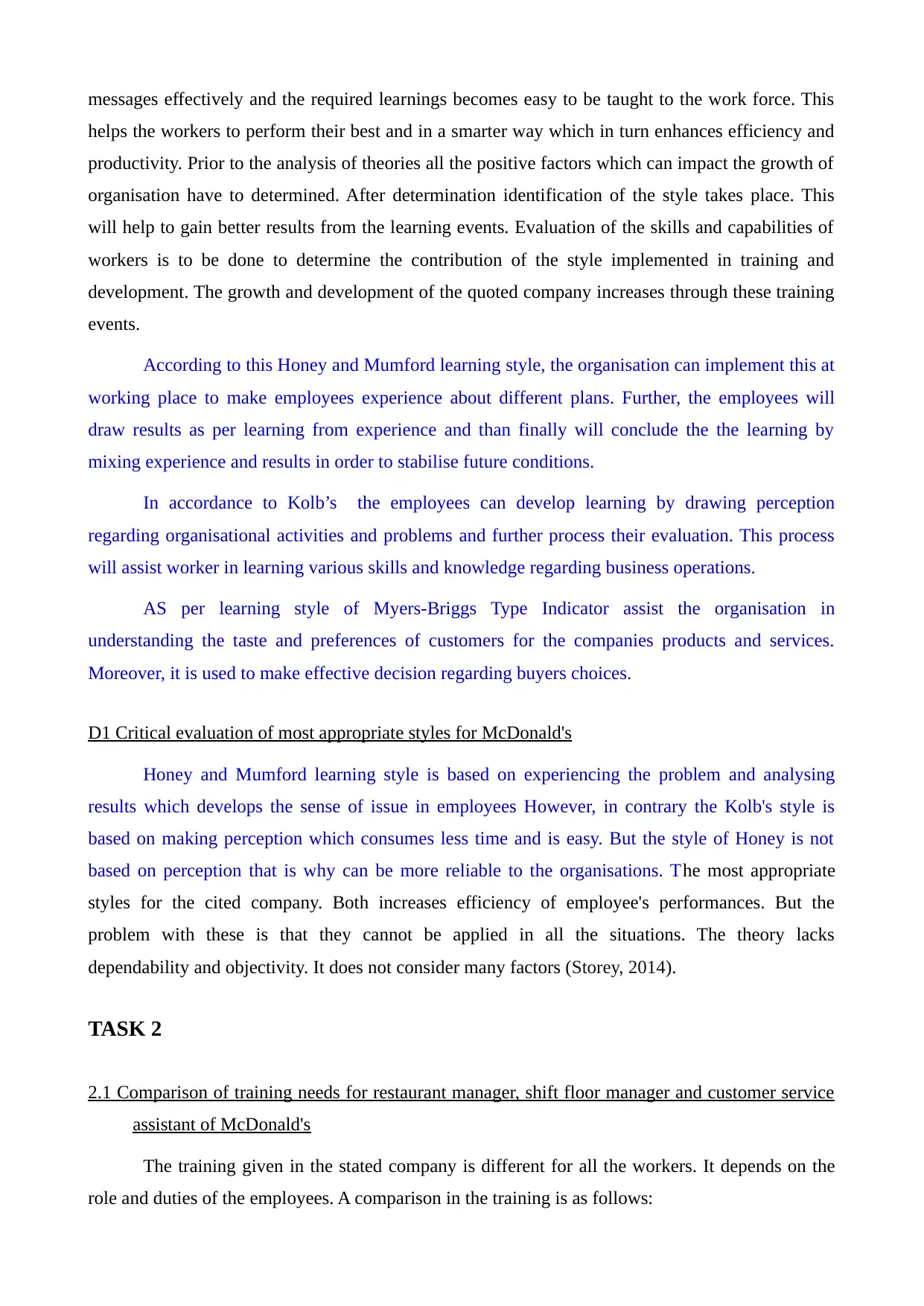
messages effectively and the required learnings becomes easy to be taught to the work force. This
helps the workers to perform their best and in a smarter way which in turn enhances efficiency and
productivity. Prior to the analysis of theories all the positive factors which can impact the growth of
organisation have to determined. After determination identification of the style takes place. This
will help to gain better results from the learning events. Evaluation of the skills and capabilities of
workers is to be done to determine the contribution of the style implemented in training and
development. The growth and development of the quoted company increases through these training
events.
According to this Honey and Mumford learning style, the organisation can implement this at
working place to make employees experience about different plans. Further, the employees will
draw results as per learning from experience and than finally will conclude the the learning by
mixing experience and results in order to stabilise future conditions.
In accordance to Kolb’s the employees can develop learning by drawing perception
regarding organisational activities and problems and further process their evaluation. This process
will assist worker in learning various skills and knowledge regarding business operations.
AS per learning style of Myers-Briggs Type Indicator assist the organisation in
understanding the taste and preferences of customers for the companies products and services.
Moreover, it is used to make effective decision regarding buyers choices.
D1 Critical evaluation of most appropriate styles for McDonald's
Honey and Mumford learning style is based on experiencing the problem and analysing
results which develops the sense of issue in employees However, in contrary the Kolb's style is
based on making perception which consumes less time and is easy. But the style of Honey is not
based on perception that is why can be more reliable to the organisations. The most appropriate
styles for the cited company. Both increases efficiency of employee's performances. But the
problem with these is that they cannot be applied in all the situations. The theory lacks
dependability and objectivity. It does not consider many factors (Storey, 2014).
TASK 2
2.1 Comparison of training needs for restaurant manager, shift floor manager and customer service
assistant of McDonald's
The training given in the stated company is different for all the workers. It depends on the
role and duties of the employees. A comparison in the training is as follows:
helps the workers to perform their best and in a smarter way which in turn enhances efficiency and
productivity. Prior to the analysis of theories all the positive factors which can impact the growth of
organisation have to determined. After determination identification of the style takes place. This
will help to gain better results from the learning events. Evaluation of the skills and capabilities of
workers is to be done to determine the contribution of the style implemented in training and
development. The growth and development of the quoted company increases through these training
events.
According to this Honey and Mumford learning style, the organisation can implement this at
working place to make employees experience about different plans. Further, the employees will
draw results as per learning from experience and than finally will conclude the the learning by
mixing experience and results in order to stabilise future conditions.
In accordance to Kolb’s the employees can develop learning by drawing perception
regarding organisational activities and problems and further process their evaluation. This process
will assist worker in learning various skills and knowledge regarding business operations.
AS per learning style of Myers-Briggs Type Indicator assist the organisation in
understanding the taste and preferences of customers for the companies products and services.
Moreover, it is used to make effective decision regarding buyers choices.
D1 Critical evaluation of most appropriate styles for McDonald's
Honey and Mumford learning style is based on experiencing the problem and analysing
results which develops the sense of issue in employees However, in contrary the Kolb's style is
based on making perception which consumes less time and is easy. But the style of Honey is not
based on perception that is why can be more reliable to the organisations. The most appropriate
styles for the cited company. Both increases efficiency of employee's performances. But the
problem with these is that they cannot be applied in all the situations. The theory lacks
dependability and objectivity. It does not consider many factors (Storey, 2014).
TASK 2
2.1 Comparison of training needs for restaurant manager, shift floor manager and customer service
assistant of McDonald's
The training given in the stated company is different for all the workers. It depends on the
role and duties of the employees. A comparison in the training is as follows:
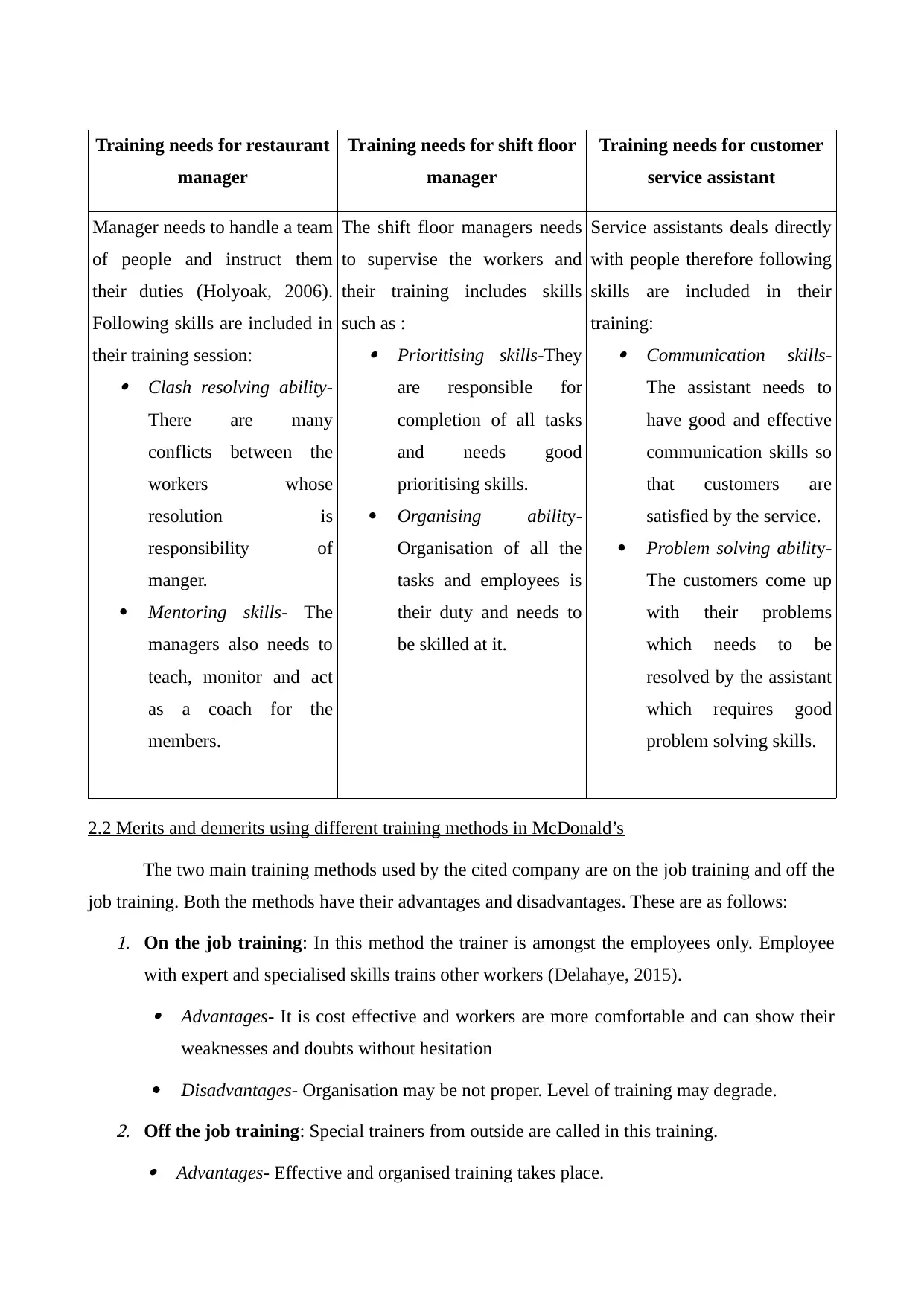
Training needs for restaurant
manager
Training needs for shift floor
manager
Training needs for customer
service assistant
Manager needs to handle a team
of people and instruct them
their duties (Holyoak, 2006).
Following skills are included in
their training session: Clash resolving ability-
There are many
conflicts between the
workers whose
resolution is
responsibility of
manger.
Mentoring skills- The
managers also needs to
teach, monitor and act
as a coach for the
members.
The shift floor managers needs
to supervise the workers and
their training includes skills
such as :
Prioritising skills-They
are responsible for
completion of all tasks
and needs good
prioritising skills.
Organising ability-
Organisation of all the
tasks and employees is
their duty and needs to
be skilled at it.
Service assistants deals directly
with people therefore following
skills are included in their
training:
Communication skills-
The assistant needs to
have good and effective
communication skills so
that customers are
satisfied by the service.
Problem solving ability-
The customers come up
with their problems
which needs to be
resolved by the assistant
which requires good
problem solving skills.
2.2 Merits and demerits using different training methods in McDonald’s
The two main training methods used by the cited company are on the job training and off the
job training. Both the methods have their advantages and disadvantages. These are as follows:
1. On the job training: In this method the trainer is amongst the employees only. Employee
with expert and specialised skills trains other workers (Delahaye, 2015). Advantages- It is cost effective and workers are more comfortable and can show their
weaknesses and doubts without hesitation
Disadvantages- Organisation may be not proper. Level of training may degrade.
2. Off the job training: Special trainers from outside are called in this training. Advantages- Effective and organised training takes place.
manager
Training needs for shift floor
manager
Training needs for customer
service assistant
Manager needs to handle a team
of people and instruct them
their duties (Holyoak, 2006).
Following skills are included in
their training session: Clash resolving ability-
There are many
conflicts between the
workers whose
resolution is
responsibility of
manger.
Mentoring skills- The
managers also needs to
teach, monitor and act
as a coach for the
members.
The shift floor managers needs
to supervise the workers and
their training includes skills
such as :
Prioritising skills-They
are responsible for
completion of all tasks
and needs good
prioritising skills.
Organising ability-
Organisation of all the
tasks and employees is
their duty and needs to
be skilled at it.
Service assistants deals directly
with people therefore following
skills are included in their
training:
Communication skills-
The assistant needs to
have good and effective
communication skills so
that customers are
satisfied by the service.
Problem solving ability-
The customers come up
with their problems
which needs to be
resolved by the assistant
which requires good
problem solving skills.
2.2 Merits and demerits using different training methods in McDonald’s
The two main training methods used by the cited company are on the job training and off the
job training. Both the methods have their advantages and disadvantages. These are as follows:
1. On the job training: In this method the trainer is amongst the employees only. Employee
with expert and specialised skills trains other workers (Delahaye, 2015). Advantages- It is cost effective and workers are more comfortable and can show their
weaknesses and doubts without hesitation
Disadvantages- Organisation may be not proper. Level of training may degrade.
2. Off the job training: Special trainers from outside are called in this training. Advantages- Effective and organised training takes place.
⊘ This is a preview!⊘
Do you want full access?
Subscribe today to unlock all pages.

Trusted by 1+ million students worldwide
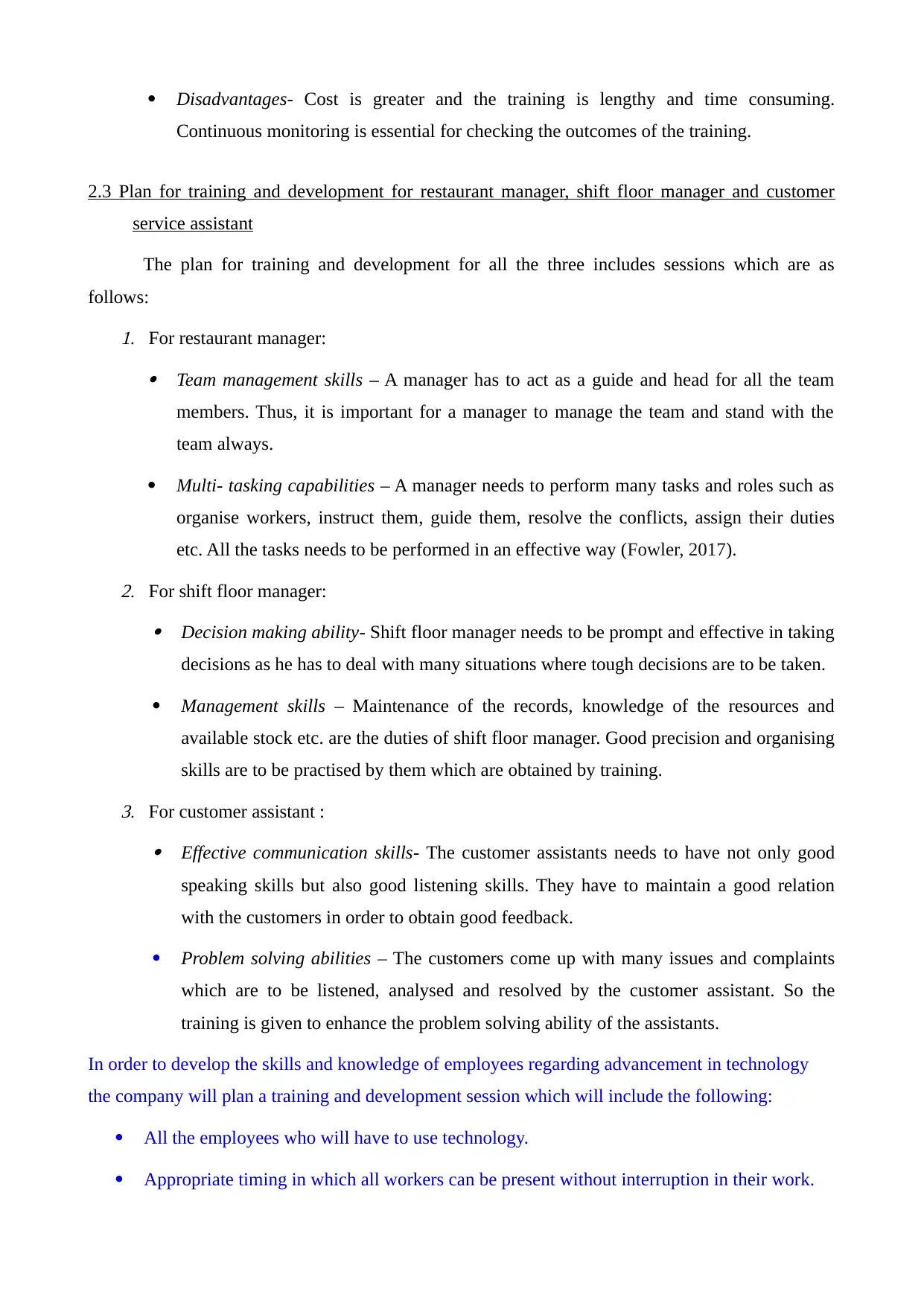
Disadvantages- Cost is greater and the training is lengthy and time consuming.
Continuous monitoring is essential for checking the outcomes of the training.
2.3 Plan for training and development for restaurant manager, shift floor manager and customer
service assistant
The plan for training and development for all the three includes sessions which are as
follows:1. For restaurant manager: Team management skills – A manager has to act as a guide and head for all the team
members. Thus, it is important for a manager to manage the team and stand with the
team always.
Multi- tasking capabilities – A manager needs to perform many tasks and roles such as
organise workers, instruct them, guide them, resolve the conflicts, assign their duties
etc. All the tasks needs to be performed in an effective way (Fowler, 2017).2. For shift floor manager: Decision making ability- Shift floor manager needs to be prompt and effective in taking
decisions as he has to deal with many situations where tough decisions are to be taken.
Management skills – Maintenance of the records, knowledge of the resources and
available stock etc. are the duties of shift floor manager. Good precision and organising
skills are to be practised by them which are obtained by training.3. For customer assistant : Effective communication skills- The customer assistants needs to have not only good
speaking skills but also good listening skills. They have to maintain a good relation
with the customers in order to obtain good feedback.
Problem solving abilities – The customers come up with many issues and complaints
which are to be listened, analysed and resolved by the customer assistant. So the
training is given to enhance the problem solving ability of the assistants.
In order to develop the skills and knowledge of employees regarding advancement in technology
the company will plan a training and development session which will include the following:
All the employees who will have to use technology.
Appropriate timing in which all workers can be present without interruption in their work.
Continuous monitoring is essential for checking the outcomes of the training.
2.3 Plan for training and development for restaurant manager, shift floor manager and customer
service assistant
The plan for training and development for all the three includes sessions which are as
follows:1. For restaurant manager: Team management skills – A manager has to act as a guide and head for all the team
members. Thus, it is important for a manager to manage the team and stand with the
team always.
Multi- tasking capabilities – A manager needs to perform many tasks and roles such as
organise workers, instruct them, guide them, resolve the conflicts, assign their duties
etc. All the tasks needs to be performed in an effective way (Fowler, 2017).2. For shift floor manager: Decision making ability- Shift floor manager needs to be prompt and effective in taking
decisions as he has to deal with many situations where tough decisions are to be taken.
Management skills – Maintenance of the records, knowledge of the resources and
available stock etc. are the duties of shift floor manager. Good precision and organising
skills are to be practised by them which are obtained by training.3. For customer assistant : Effective communication skills- The customer assistants needs to have not only good
speaking skills but also good listening skills. They have to maintain a good relation
with the customers in order to obtain good feedback.
Problem solving abilities – The customers come up with many issues and complaints
which are to be listened, analysed and resolved by the customer assistant. So the
training is given to enhance the problem solving ability of the assistants.
In order to develop the skills and knowledge of employees regarding advancement in technology
the company will plan a training and development session which will include the following:
All the employees who will have to use technology.
Appropriate timing in which all workers can be present without interruption in their work.
Paraphrase This Document
Need a fresh take? Get an instant paraphrase of this document with our AI Paraphraser
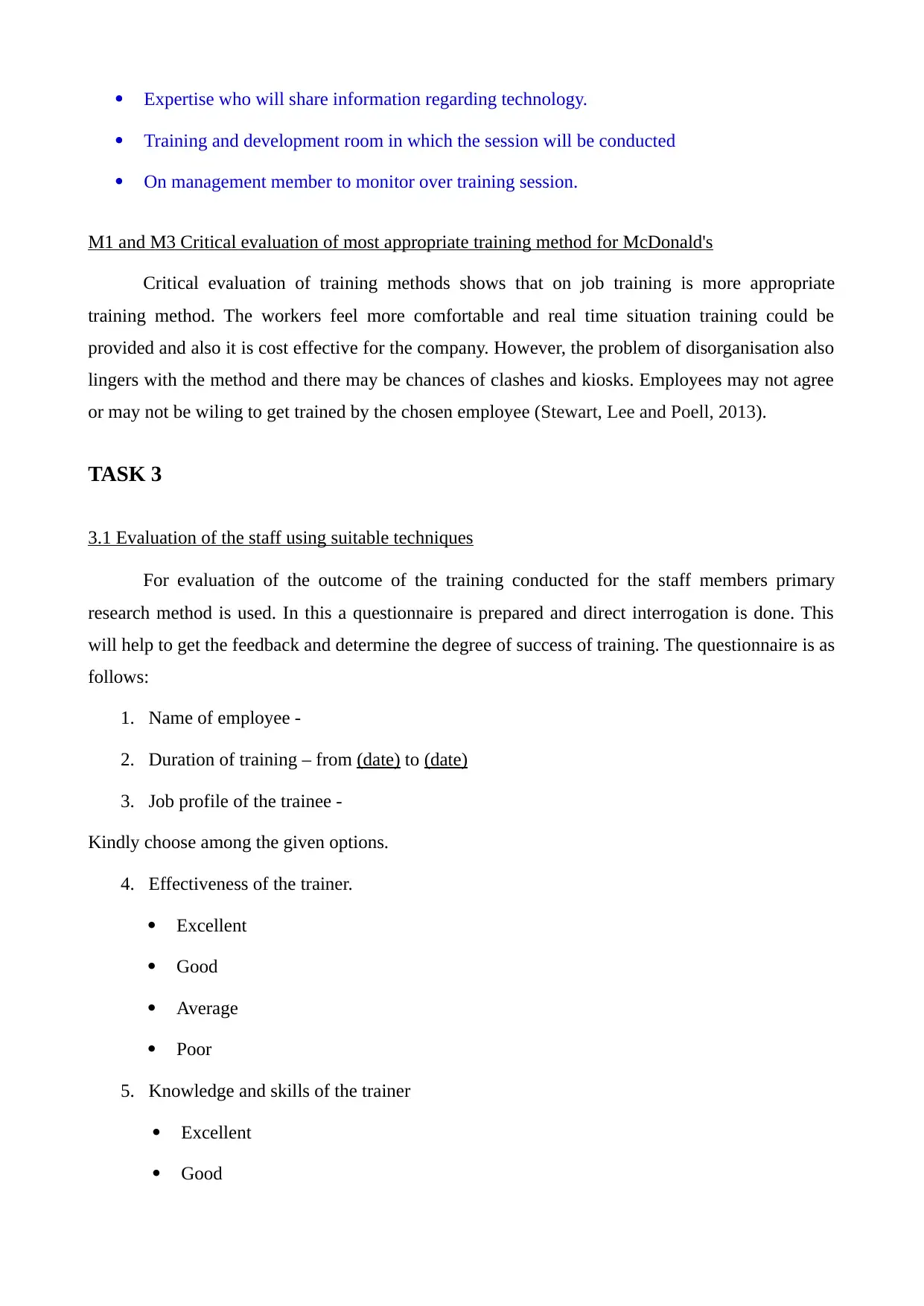
Expertise who will share information regarding technology.
Training and development room in which the session will be conducted
On management member to monitor over training session.
M1 and M3 Critical evaluation of most appropriate training method for McDonald's
Critical evaluation of training methods shows that on job training is more appropriate
training method. The workers feel more comfortable and real time situation training could be
provided and also it is cost effective for the company. However, the problem of disorganisation also
lingers with the method and there may be chances of clashes and kiosks. Employees may not agree
or may not be wiling to get trained by the chosen employee (Stewart, Lee and Poell, 2013).
TASK 3
3.1 Evaluation of the staff using suitable techniques
For evaluation of the outcome of the training conducted for the staff members primary
research method is used. In this a questionnaire is prepared and direct interrogation is done. This
will help to get the feedback and determine the degree of success of training. The questionnaire is as
follows:
1. Name of employee -
2. Duration of training – from (date) to (date)
3. Job profile of the trainee -
Kindly choose among the given options.
4. Effectiveness of the trainer.
Excellent
Good
Average
Poor
5. Knowledge and skills of the trainer
Excellent
Good
Training and development room in which the session will be conducted
On management member to monitor over training session.
M1 and M3 Critical evaluation of most appropriate training method for McDonald's
Critical evaluation of training methods shows that on job training is more appropriate
training method. The workers feel more comfortable and real time situation training could be
provided and also it is cost effective for the company. However, the problem of disorganisation also
lingers with the method and there may be chances of clashes and kiosks. Employees may not agree
or may not be wiling to get trained by the chosen employee (Stewart, Lee and Poell, 2013).
TASK 3
3.1 Evaluation of the staff using suitable techniques
For evaluation of the outcome of the training conducted for the staff members primary
research method is used. In this a questionnaire is prepared and direct interrogation is done. This
will help to get the feedback and determine the degree of success of training. The questionnaire is as
follows:
1. Name of employee -
2. Duration of training – from (date) to (date)
3. Job profile of the trainee -
Kindly choose among the given options.
4. Effectiveness of the trainer.
Excellent
Good
Average
Poor
5. Knowledge and skills of the trainer
Excellent
Good
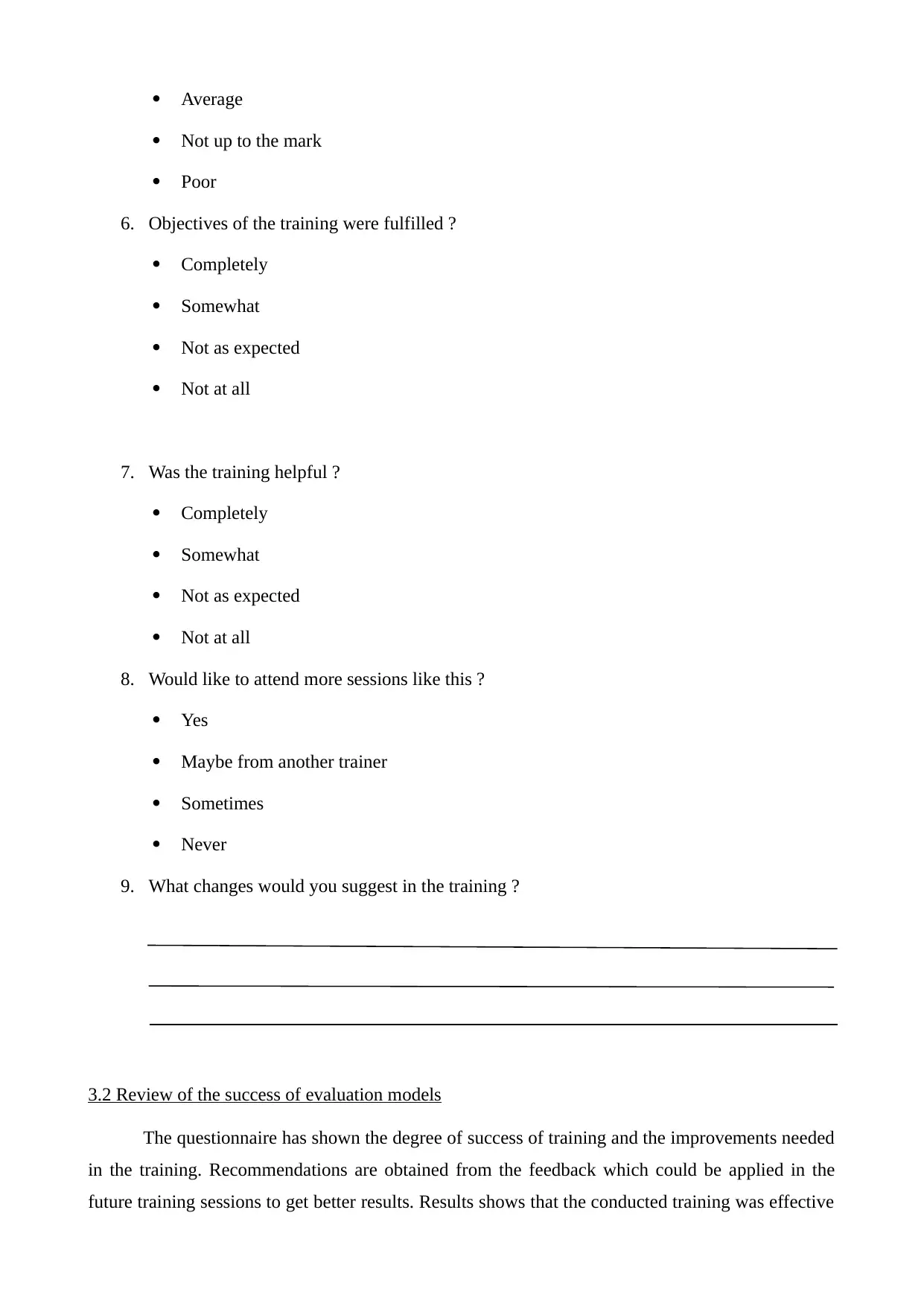
Average
Not up to the mark
Poor
6. Objectives of the training were fulfilled ?
Completely
Somewhat
Not as expected
Not at all
7. Was the training helpful ?
Completely
Somewhat
Not as expected
Not at all
8. Would like to attend more sessions like this ?
Yes
Maybe from another trainer
Sometimes
Never
9. What changes would you suggest in the training ?
3.2 Review of the success of evaluation models
The questionnaire has shown the degree of success of training and the improvements needed
in the training. Recommendations are obtained from the feedback which could be applied in the
future training sessions to get better results. Results shows that the conducted training was effective
Not up to the mark
Poor
6. Objectives of the training were fulfilled ?
Completely
Somewhat
Not as expected
Not at all
7. Was the training helpful ?
Completely
Somewhat
Not as expected
Not at all
8. Would like to attend more sessions like this ?
Yes
Maybe from another trainer
Sometimes
Never
9. What changes would you suggest in the training ?
3.2 Review of the success of evaluation models
The questionnaire has shown the degree of success of training and the improvements needed
in the training. Recommendations are obtained from the feedback which could be applied in the
future training sessions to get better results. Results shows that the conducted training was effective
⊘ This is a preview!⊘
Do you want full access?
Subscribe today to unlock all pages.

Trusted by 1+ million students worldwide
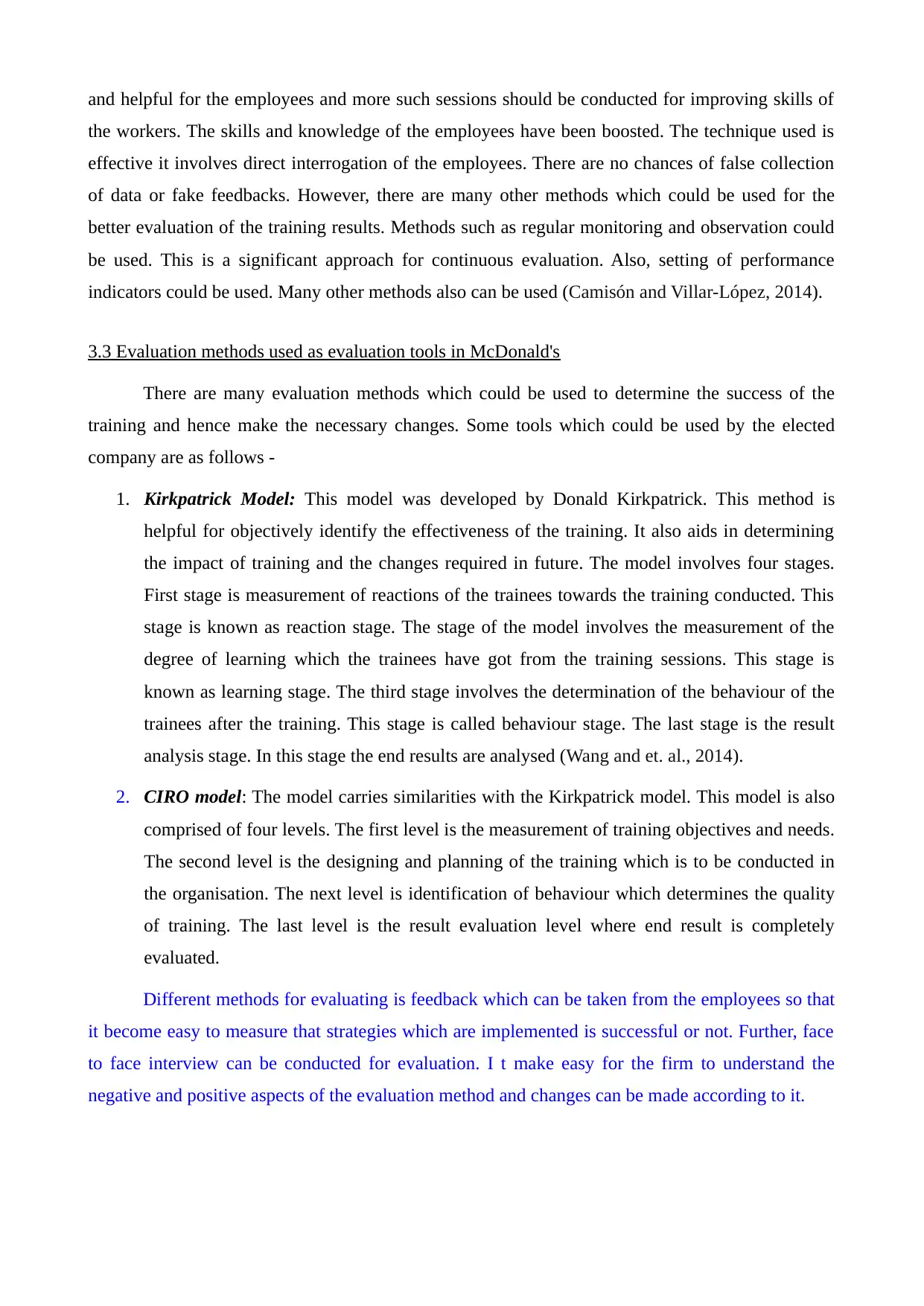
and helpful for the employees and more such sessions should be conducted for improving skills of
the workers. The skills and knowledge of the employees have been boosted. The technique used is
effective it involves direct interrogation of the employees. There are no chances of false collection
of data or fake feedbacks. However, there are many other methods which could be used for the
better evaluation of the training results. Methods such as regular monitoring and observation could
be used. This is a significant approach for continuous evaluation. Also, setting of performance
indicators could be used. Many other methods also can be used (Camisón and Villar-López, 2014).
3.3 Evaluation methods used as evaluation tools in McDonald's
There are many evaluation methods which could be used to determine the success of the
training and hence make the necessary changes. Some tools which could be used by the elected
company are as follows -
1. Kirkpatrick Model: This model was developed by Donald Kirkpatrick. This method is
helpful for objectively identify the effectiveness of the training. It also aids in determining
the impact of training and the changes required in future. The model involves four stages.
First stage is measurement of reactions of the trainees towards the training conducted. This
stage is known as reaction stage. The stage of the model involves the measurement of the
degree of learning which the trainees have got from the training sessions. This stage is
known as learning stage. The third stage involves the determination of the behaviour of the
trainees after the training. This stage is called behaviour stage. The last stage is the result
analysis stage. In this stage the end results are analysed (Wang and et. al., 2014).
2. CIRO model: The model carries similarities with the Kirkpatrick model. This model is also
comprised of four levels. The first level is the measurement of training objectives and needs.
The second level is the designing and planning of the training which is to be conducted in
the organisation. The next level is identification of behaviour which determines the quality
of training. The last level is the result evaluation level where end result is completely
evaluated.
Different methods for evaluating is feedback which can be taken from the employees so that
it become easy to measure that strategies which are implemented is successful or not. Further, face
to face interview can be conducted for evaluation. I t make easy for the firm to understand the
negative and positive aspects of the evaluation method and changes can be made according to it.
the workers. The skills and knowledge of the employees have been boosted. The technique used is
effective it involves direct interrogation of the employees. There are no chances of false collection
of data or fake feedbacks. However, there are many other methods which could be used for the
better evaluation of the training results. Methods such as regular monitoring and observation could
be used. This is a significant approach for continuous evaluation. Also, setting of performance
indicators could be used. Many other methods also can be used (Camisón and Villar-López, 2014).
3.3 Evaluation methods used as evaluation tools in McDonald's
There are many evaluation methods which could be used to determine the success of the
training and hence make the necessary changes. Some tools which could be used by the elected
company are as follows -
1. Kirkpatrick Model: This model was developed by Donald Kirkpatrick. This method is
helpful for objectively identify the effectiveness of the training. It also aids in determining
the impact of training and the changes required in future. The model involves four stages.
First stage is measurement of reactions of the trainees towards the training conducted. This
stage is known as reaction stage. The stage of the model involves the measurement of the
degree of learning which the trainees have got from the training sessions. This stage is
known as learning stage. The third stage involves the determination of the behaviour of the
trainees after the training. This stage is called behaviour stage. The last stage is the result
analysis stage. In this stage the end results are analysed (Wang and et. al., 2014).
2. CIRO model: The model carries similarities with the Kirkpatrick model. This model is also
comprised of four levels. The first level is the measurement of training objectives and needs.
The second level is the designing and planning of the training which is to be conducted in
the organisation. The next level is identification of behaviour which determines the quality
of training. The last level is the result evaluation level where end result is completely
evaluated.
Different methods for evaluating is feedback which can be taken from the employees so that
it become easy to measure that strategies which are implemented is successful or not. Further, face
to face interview can be conducted for evaluation. I t make easy for the firm to understand the
negative and positive aspects of the evaluation method and changes can be made according to it.
Paraphrase This Document
Need a fresh take? Get an instant paraphrase of this document with our AI Paraphraser
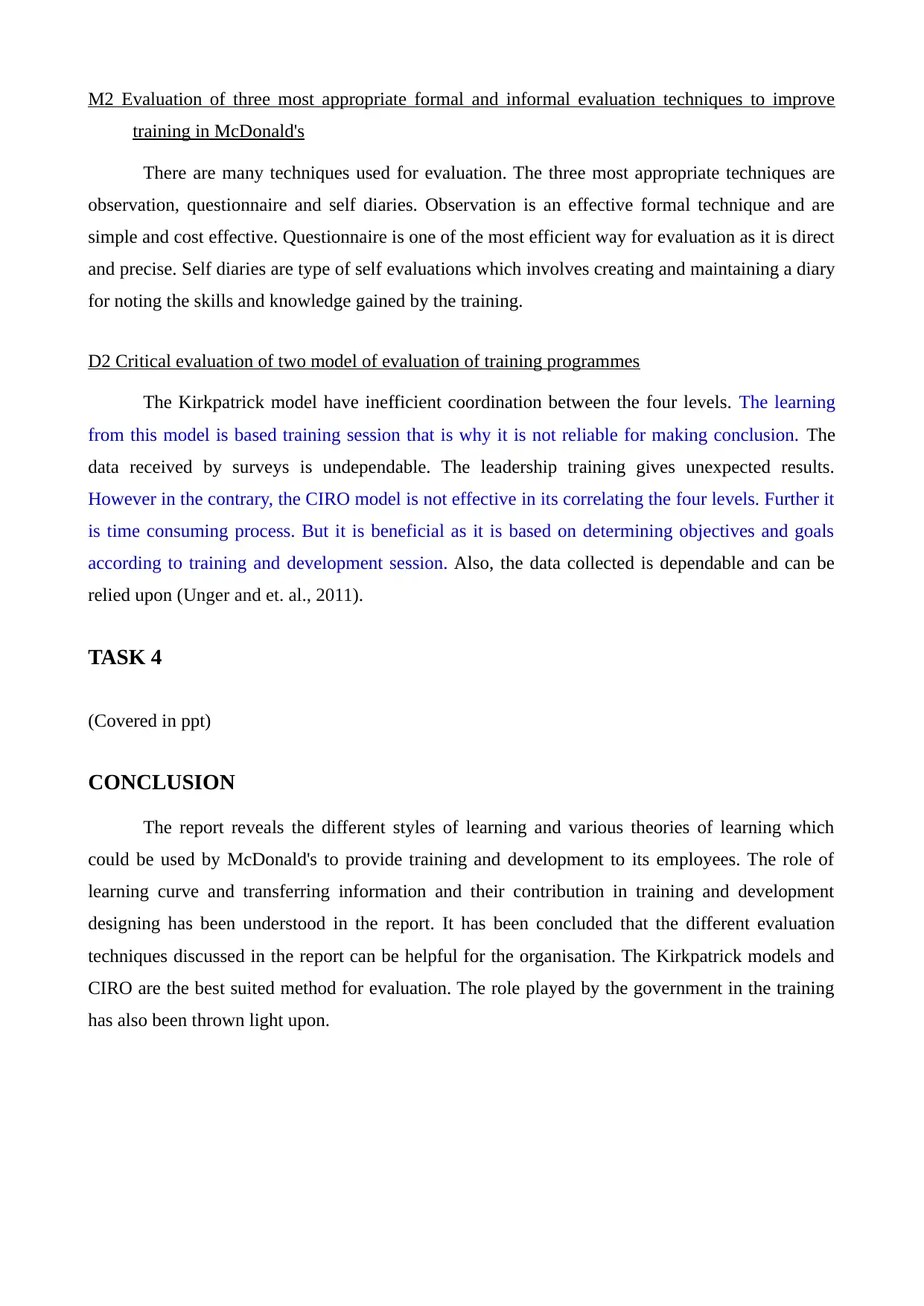
M2 Evaluation of three most appropriate formal and informal evaluation techniques to improve
training in McDonald's
There are many techniques used for evaluation. The three most appropriate techniques are
observation, questionnaire and self diaries. Observation is an effective formal technique and are
simple and cost effective. Questionnaire is one of the most efficient way for evaluation as it is direct
and precise. Self diaries are type of self evaluations which involves creating and maintaining a diary
for noting the skills and knowledge gained by the training.
D2 Critical evaluation of two model of evaluation of training programmes
The Kirkpatrick model have inefficient coordination between the four levels. The learning
from this model is based training session that is why it is not reliable for making conclusion. The
data received by surveys is undependable. The leadership training gives unexpected results.
However in the contrary, the CIRO model is not effective in its correlating the four levels. Further it
is time consuming process. But it is beneficial as it is based on determining objectives and goals
according to training and development session. Also, the data collected is dependable and can be
relied upon (Unger and et. al., 2011).
TASK 4
(Covered in ppt)
CONCLUSION
The report reveals the different styles of learning and various theories of learning which
could be used by McDonald's to provide training and development to its employees. The role of
learning curve and transferring information and their contribution in training and development
designing has been understood in the report. It has been concluded that the different evaluation
techniques discussed in the report can be helpful for the organisation. The Kirkpatrick models and
CIRO are the best suited method for evaluation. The role played by the government in the training
has also been thrown light upon.
training in McDonald's
There are many techniques used for evaluation. The three most appropriate techniques are
observation, questionnaire and self diaries. Observation is an effective formal technique and are
simple and cost effective. Questionnaire is one of the most efficient way for evaluation as it is direct
and precise. Self diaries are type of self evaluations which involves creating and maintaining a diary
for noting the skills and knowledge gained by the training.
D2 Critical evaluation of two model of evaluation of training programmes
The Kirkpatrick model have inefficient coordination between the four levels. The learning
from this model is based training session that is why it is not reliable for making conclusion. The
data received by surveys is undependable. The leadership training gives unexpected results.
However in the contrary, the CIRO model is not effective in its correlating the four levels. Further it
is time consuming process. But it is beneficial as it is based on determining objectives and goals
according to training and development session. Also, the data collected is dependable and can be
relied upon (Unger and et. al., 2011).
TASK 4
(Covered in ppt)
CONCLUSION
The report reveals the different styles of learning and various theories of learning which
could be used by McDonald's to provide training and development to its employees. The role of
learning curve and transferring information and their contribution in training and development
designing has been understood in the report. It has been concluded that the different evaluation
techniques discussed in the report can be helpful for the organisation. The Kirkpatrick models and
CIRO are the best suited method for evaluation. The role played by the government in the training
has also been thrown light upon.
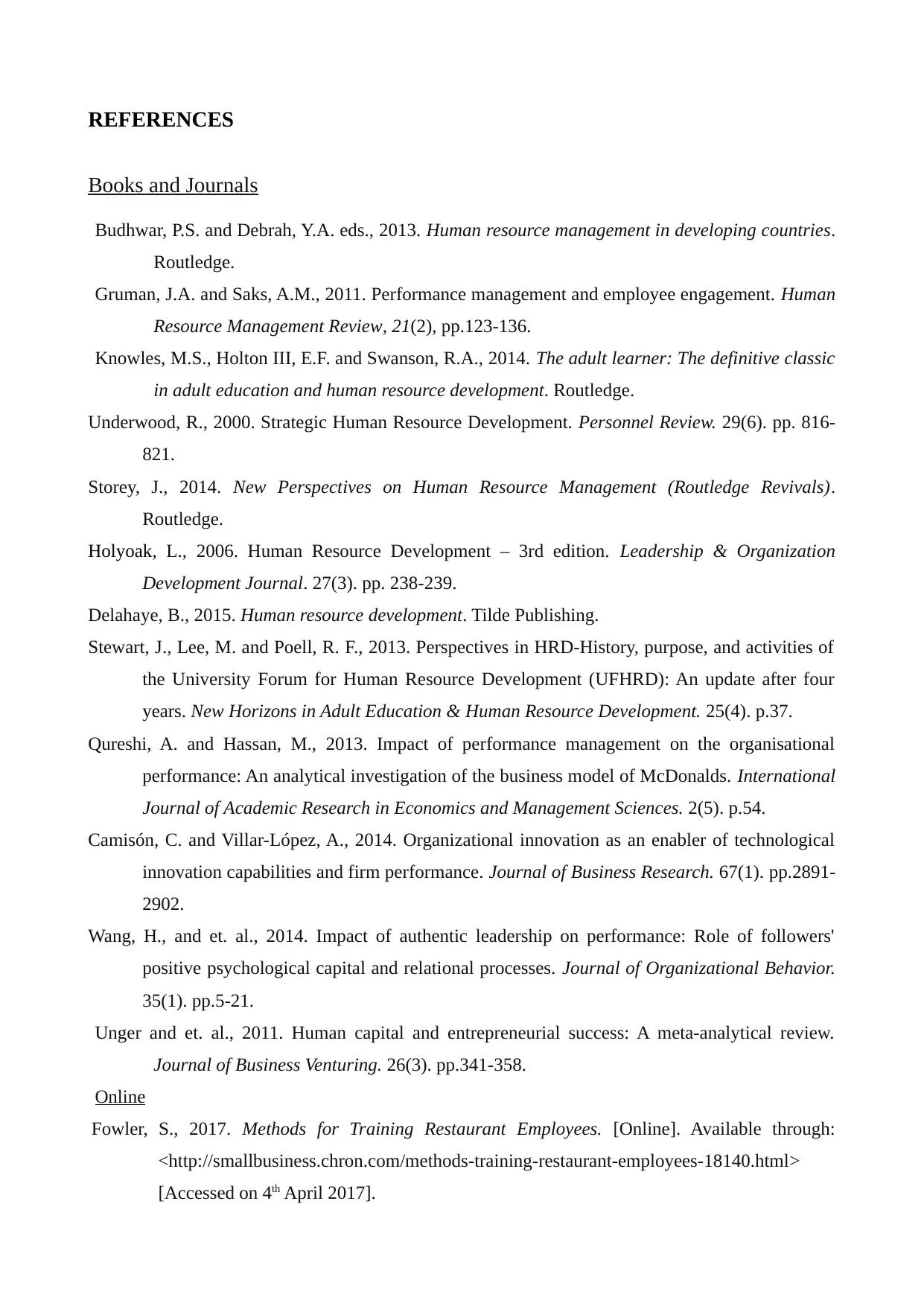
REFERENCES
Books and Journals
Budhwar, P.S. and Debrah, Y.A. eds., 2013. Human resource management in developing countries.
Routledge.
Gruman, J.A. and Saks, A.M., 2011. Performance management and employee engagement. Human
Resource Management Review, 21(2), pp.123-136.
Knowles, M.S., Holton III, E.F. and Swanson, R.A., 2014. The adult learner: The definitive classic
in adult education and human resource development. Routledge.
Underwood, R., 2000. Strategic Human Resource Development. Personnel Review. 29(6). pp. 816-
821.
Storey, J., 2014. New Perspectives on Human Resource Management (Routledge Revivals).
Routledge.
Holyoak, L., 2006. Human Resource Development – 3rd edition. Leadership & Organization
Development Journal. 27(3). pp. 238-239.
Delahaye, B., 2015. Human resource development. Tilde Publishing.
Stewart, J., Lee, M. and Poell, R. F., 2013. Perspectives in HRD-History, purpose, and activities of
the University Forum for Human Resource Development (UFHRD): An update after four
years. New Horizons in Adult Education & Human Resource Development. 25(4). p.37.
Qureshi, A. and Hassan, M., 2013. Impact of performance management on the organisational
performance: An analytical investigation of the business model of McDonalds. International
Journal of Academic Research in Economics and Management Sciences. 2(5). p.54.
Camisón, C. and Villar-López, A., 2014. Organizational innovation as an enabler of technological
innovation capabilities and firm performance. Journal of Business Research. 67(1). pp.2891-
2902.
Wang, H., and et. al., 2014. Impact of authentic leadership on performance: Role of followers'
positive psychological capital and relational processes. Journal of Organizational Behavior.
35(1). pp.5-21.
Unger and et. al., 2011. Human capital and entrepreneurial success: A meta-analytical review.
Journal of Business Venturing. 26(3). pp.341-358.
Online
Fowler, S., 2017. Methods for Training Restaurant Employees. [Online]. Available through:
<http://smallbusiness.chron.com/methods-training-restaurant-employees-18140.html>
[Accessed on 4th April 2017].
Books and Journals
Budhwar, P.S. and Debrah, Y.A. eds., 2013. Human resource management in developing countries.
Routledge.
Gruman, J.A. and Saks, A.M., 2011. Performance management and employee engagement. Human
Resource Management Review, 21(2), pp.123-136.
Knowles, M.S., Holton III, E.F. and Swanson, R.A., 2014. The adult learner: The definitive classic
in adult education and human resource development. Routledge.
Underwood, R., 2000. Strategic Human Resource Development. Personnel Review. 29(6). pp. 816-
821.
Storey, J., 2014. New Perspectives on Human Resource Management (Routledge Revivals).
Routledge.
Holyoak, L., 2006. Human Resource Development – 3rd edition. Leadership & Organization
Development Journal. 27(3). pp. 238-239.
Delahaye, B., 2015. Human resource development. Tilde Publishing.
Stewart, J., Lee, M. and Poell, R. F., 2013. Perspectives in HRD-History, purpose, and activities of
the University Forum for Human Resource Development (UFHRD): An update after four
years. New Horizons in Adult Education & Human Resource Development. 25(4). p.37.
Qureshi, A. and Hassan, M., 2013. Impact of performance management on the organisational
performance: An analytical investigation of the business model of McDonalds. International
Journal of Academic Research in Economics and Management Sciences. 2(5). p.54.
Camisón, C. and Villar-López, A., 2014. Organizational innovation as an enabler of technological
innovation capabilities and firm performance. Journal of Business Research. 67(1). pp.2891-
2902.
Wang, H., and et. al., 2014. Impact of authentic leadership on performance: Role of followers'
positive psychological capital and relational processes. Journal of Organizational Behavior.
35(1). pp.5-21.
Unger and et. al., 2011. Human capital and entrepreneurial success: A meta-analytical review.
Journal of Business Venturing. 26(3). pp.341-358.
Online
Fowler, S., 2017. Methods for Training Restaurant Employees. [Online]. Available through:
<http://smallbusiness.chron.com/methods-training-restaurant-employees-18140.html>
[Accessed on 4th April 2017].
⊘ This is a preview!⊘
Do you want full access?
Subscribe today to unlock all pages.

Trusted by 1+ million students worldwide
1 out of 13
Related Documents
Your All-in-One AI-Powered Toolkit for Academic Success.
+13062052269
info@desklib.com
Available 24*7 on WhatsApp / Email
![[object Object]](/_next/static/media/star-bottom.7253800d.svg)
Unlock your academic potential
Copyright © 2020–2025 A2Z Services. All Rights Reserved. Developed and managed by ZUCOL.





